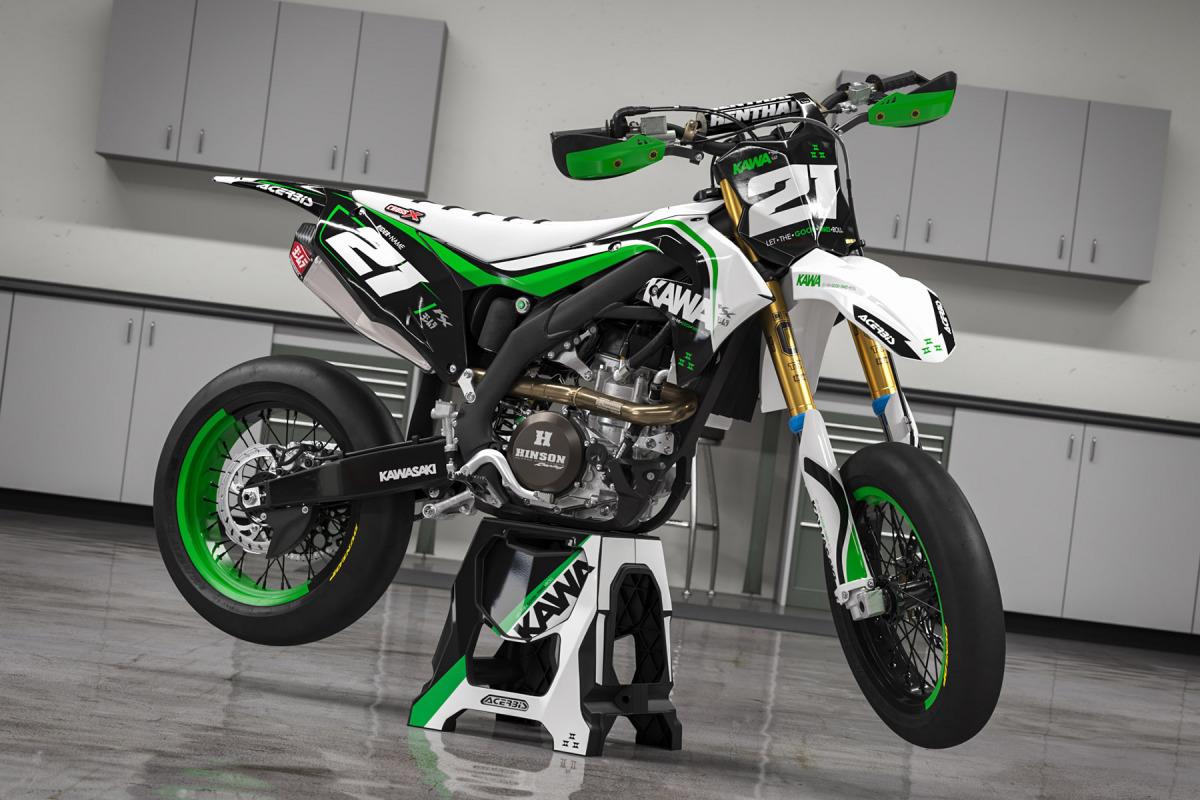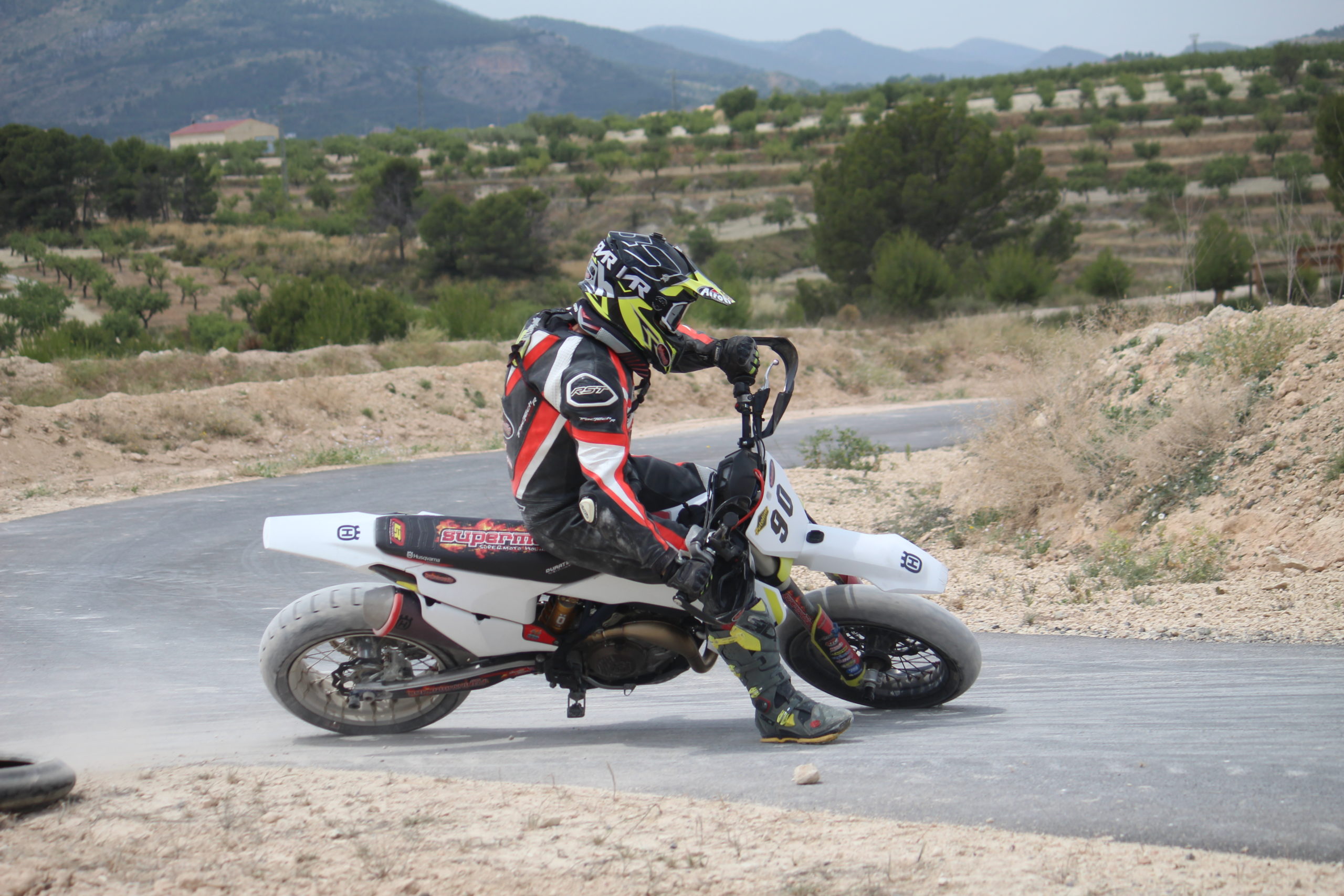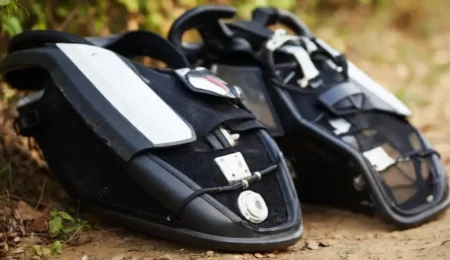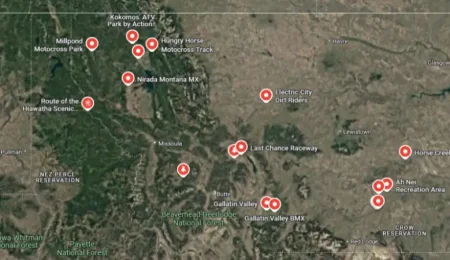Dirt bikes and supermotos are both thrilling to ride, yet they serve different purposes. Understanding their differences can help you choose the right one for your needs.
Dirt bikes are designed for off-road adventures. They excel on rough terrains, like trails and motocross tracks. Supermotos, on the other hand, are adapted for street use. They combine features of dirt bikes with elements suited for paved roads. This comparison helps you grasp which bike fits your riding style better.
Knowing the differences can save you time and money, ensuring you pick the right bike for your adventures. Let’s explore these differences to make an informed decision.

Credit: omxgraphics.com
Dirt Bike Basics
When exploring the world of motorcycles, you might come across two popular types: the Dirt Bike and the Supermoto. Understanding their differences can help you choose the right one for your needs. This section focuses on Dirt Bike Basics, providing insight into their key features and common uses.
Key Features
Dirt Bikes are designed for off-road adventures. They have specific characteristics that make them perfect for rough terrains and trails. Here are some key features:
- Lightweight Frames: Dirt Bikes have lightweight frames, ensuring easy maneuverability on rough paths.
- High Ground Clearance: The high ground clearance helps navigate over rocks, roots, and other obstacles.
- Knobby Tires: The aggressive tire tread patterns provide excellent grip on dirt, mud, and loose surfaces.
- Long-Travel Suspension: These bikes come with a robust suspension system, absorbing shocks from uneven terrains and jumps.
- Simple Engine Design: Dirt Bikes typically feature a single-cylinder engine for reliability and ease of maintenance.
Below is a table summarizing the key features of Dirt Bikes:
| Feature | Description |
|---|---|
| Lightweight Frames | Enhances maneuverability |
| High Ground Clearance | Allows easy navigation over obstacles |
| Knobby Tires | Provides grip on loose surfaces |
| Long-Travel Suspension | Absorbs shocks from uneven terrains |
| Simple Engine Design | Ensures reliability and easy maintenance |
Common Uses
Dirt Bikes are versatile and can be used in various scenarios. Here are some common uses:
- Trail Riding: Dirt Bikes are perfect for trail riding through forests, hills, and rugged paths. Their handling characteristics allow riders to navigate tight turns and steep climbs.
- Motocross Racing: These bikes are commonly used in motocross racing. Their engine performance and suspension system are optimized for jumps and rapid acceleration on dirt tracks.
- Enduro Competitions: Dirt Bikes excel in enduro competitions. They perform well over long distances and various terrains, including forests, mountains, and deserts.
- Recreational Riding: Many enthusiasts use Dirt Bikes for recreational riding. They offer a thrilling experience on off-road trails and open fields.
Dirt Bikes are not typically street-legal bikes. They lack features required for road use, such as headlights, mirrors, and turn signals. Riders should ensure they have proper gear, including helmets, gloves, and protective clothing.
The versatility of Dirt Bikes makes them a popular choice for off-road enthusiasts. Whether you enjoy trail riding or competitive racing, these motorcycles provide an exciting and adventurous experience.
Supermoto Essentials
Introduction paragraph about What is the Difference between a Dirt Bike And a Supermoto and Supermoto Essentials…
Design Elements
Supermoto motorcycles stand out due to their unique design elements. Unlike traditional dirt bikes, which are built for off-road terrains, supermotos are designed for versatility. This allows them to perform well on both paved and unpaved surfaces. Below are key design elements that differentiate supermotos from dirt bikes:
- Tire Types: Supermotos use slick or semi-slick tires for better grip on asphalt, whereas dirt bikes have knobby tires for rough terrain.
- Suspension Differences: Supermotos generally feature stiffer suspension settings compared to the softer, more flexible suspensions on dirt bikes.
- Brake Systems: Supermotos have larger, more powerful brakes designed for high-speed stops on pavement. Dirt bikes use lighter brakes suitable for off-road conditions.
- Riding Position: The riding position on a supermoto is more upright and comfortable for street riding, while dirt bikes have a more aggressive stance suitable for off-road maneuvers.
These design elements make supermotos highly adaptable motorcycles. They can be ridden comfortably on city streets and perform well in off-road conditions. Below is a table summarizing the design differences:
| Feature | Supermoto | Dirt Bike |
|---|---|---|
| Tires | Slick or Semi-Slick | Knobby |
| Suspension | Stiffer | Softer |
| Brakes | Larger, Powerful | Lighter |
| Riding Position | Upright | Aggressive |
Performance Focus
Supermotos are tailored for a performance focus that bridges the gap between street and off-road motorcycles. Their performance specifications cater to a wide range of riding styles and terrains. Below are some key aspects of their performance focus:
- Versatility In Terrain: Supermotos excel in both urban environments and light off-road conditions. This makes them highly versatile.
- Street Legal Bikes: Most supermotos are street legal, meaning they can be ridden on public roads. This adds to their practical appeal.
- Enhanced Handling: The combination of stiffer suspension and specialized tires ensures superior handling on paved roads.
- Braking Power: Larger brakes provide better stopping power, important for high-speed urban riding.
In contrast, dirt bikes are built primarily for off-road use. Their performance features are optimized for rough, uneven terrains. Below is a comparison of performance aspects:
| Aspect | Supermoto | Dirt Bike |
|---|---|---|
| Terrain | Both Urban and Light Off-Road | Primarily Off-Road |
| Street Legal | Yes | No |
| Handling | Enhanced for Pavement | Optimized for Rough Terrain |
| Braking | Powerful for High-Speed Stops | Lighter for Off-Road Use |
These performance focuses highlight the major differences in motorcycle classifications. Supermotos provide a balance between street and off-road capabilities, making them a versatile choice for riders. Dirt bikes, on the other hand, focus on excelling in challenging off-road environments.
Tires And Traction
When it comes to understanding the difference between a dirt bike and a Supermoto, one of the most important factors to consider is tires and traction. The type of tires on these bikes plays a crucial role in their performance, especially in different riding environments. Let’s dive into the specifics of dirt bike tires and Supermoto tires to see how they impact grip and traction.
Dirt Bike Tires
Dirt bike tires are specially designed to handle off-road conditions. These tires are crucial for any off-road motorcycle because they provide the necessary grip and traction on uneven surfaces. Key features of dirt bike tires include:
- Knobby Tread: The most distinctive feature is the knobby tread pattern. This allows for better grip on loose dirt, mud, and gravel.
- Soft Rubber Compound: Dirt bike tires use a softer rubber compound, which enhances traction on soft and uneven terrains.
- High Profile: These tires have a higher profile, meaning they are taller and narrower. This helps in absorbing shocks and navigating through rough trails.
To illustrate the differences better, here is a table comparing dirt bike tires to street motorcycle tires:
| Feature | Dirt Bike Tires | Street Motorcycle Tires |
|---|---|---|
| Terrain | Off-road, trails, motocross | Asphalt, paved roads |
| Tread Pattern | Knobby | Slick or minimal tread |
| Rubber Compound | Soft | Hard |
| Profile | High | Low |
Supermoto Tires
Supermoto tires are designed for a blend of on-road and off-road performance. These tires are essential for dual-sport bikes because they provide a balance between grip and durability. Key features of Supermoto tires include:
- Slick Tread: Unlike dirt bike tires, Supermoto tires have a slick or semi-slick tread pattern. This improves grip on asphalt surfaces.
- Harder Rubber Compound: The rubber compound is harder, which enhances durability and performance on paved roads.
- Wider Profile: Supermoto tires have a wider profile, providing better stability and cornering on streets.
Here’s a quick comparison to highlight the differences between Supermoto tires and traditional dirt bike tires:
| Feature | Supermoto Tires | Dirt Bike Tires |
|---|---|---|
| Terrain | Mixed (street and light off-road) | Off-road, trails, motocross |
| Tread Pattern | Slick or semi-slick | Knobby |
| Rubber Compound | Hard | Soft |
| Profile | Wide | High |
Understanding these differences in tire types can significantly affect your riding performance. Whether you ride a dirt bike or a Supermoto, choosing the right tires is key to maximizing grip and traction.

Credit: omxgraphics.com
Suspension Differences
Understanding the differences between a dirt bike and a supermoto is crucial for any motorcycle enthusiast. One of the most significant differences lies in their suspension systems. Each type of bike is designed for a specific purpose, and their suspensions reflect this. Let’s dive into the details of the suspension systems for both dirt bikes and supermotos.
Dirt Bike Suspension
Dirt bikes are designed to handle rough, uneven terrain. Their suspension system is built to absorb shocks from rocks, roots, and jumps. Here are some key features of dirt bike suspension:
- Long Travel Suspension: Dirt bikes typically have long travel suspension, often ranging from 10 to 12 inches. This allows the bike to handle large bumps and jumps with ease.
- High Ground Clearance: The suspension system is set up to provide high ground clearance, which helps to avoid obstacles on the trail.
- Soft Suspension: The suspension on a dirt bike is generally softer compared to a supermoto. This softness helps to absorb the impact of rough terrain.
- Adjustability: Many dirt bikes come with adjustable suspension components. Riders can tweak the settings to suit their weight, riding style, and the terrain.
The table below highlights some common specifications of dirt bike suspension:
| Component | Specification |
|---|---|
| Front Fork Travel | 10-12 inches |
| Rear Shock Travel | 10-12 inches |
| Ground Clearance | 12 inches+ |
Supermoto Suspension
Supermotos are designed for a mix of paved roads and light off-road use. Their suspension system is quite different from that of a dirt bike. Here are some key features of supermoto suspension:
- Shorter Travel Suspension: Supermotos usually have shorter travel suspension, ranging from 6 to 8 inches. This provides better handling on paved surfaces.
- Lower Ground Clearance: The suspension system is set up to provide lower ground clearance, which improves stability and handling on asphalt.
- Stiffer Suspension: Supermoto suspension is generally stiffer compared to dirt bikes. This stiffness helps the bike perform better in cornering and braking on roads.
- Adjustability: Like dirt bikes, many supermotos come with adjustable suspension. Riders can fine-tune the settings for different riding conditions.
The table below highlights some common specifications of supermoto suspension:
| Component | Specification |
|---|---|
| Front Fork Travel | 6-8 inches |
| Rear Shock Travel | 6-8 inches |
| Ground Clearance | 10 inches |
Terrain Compatibility
When exploring the world of motorcycles, understanding the difference between a dirt bike and a supermoto is crucial, especially in terms of terrain compatibility. Both bikes are designed for specific environments, and their capabilities shine in different settings. Let’s dive into the key differences with a focus on terrain compatibility.
Off-road Capabilities
Dirt bikes are designed primarily for off-road use. Their features cater to rough terrains, making them excellent choices for trails, forests, and mountains. Here are some key dirt bike features that enhance their off-road capabilities:
- Tire Types: Dirt bikes come with knobby tires that provide excellent grip on loose dirt, mud, and rocky surfaces.
- Suspension Differences: They have long-travel suspension systems that absorb shocks from rough terrain, ensuring a smoother ride.
- Handling Capabilities: Lightweight frames and high ground clearance make dirt bikes easy to maneuver over obstacles and uneven ground.
Off-road motorcycles are built for rugged environments. Their design includes high fenders to prevent mud clogging, and their engines are tuned for low-end torque. This helps riders maintain control at low speeds on challenging trails.
Overall, dirt bikes excel in off-road performance due to their specialized components and design, making them the best choice for adventure seekers who love exploring unpaved paths.
On-road Performance
Supermoto bikes, on the other hand, are designed for both on-road and light off-road use. These street-legal bikes offer a blend of dirt bike agility and road bike stability. Here are some supermoto characteristics that enhance their on-road performance:
- Tire Types: Supermotos use slick or semi-slick tires, providing better grip and handling on paved roads.
- Engine Performance: Their engines are often tuned for higher speeds, offering better acceleration and top speed compared to dirt bikes.
- Riding Styles: Supermotos are designed for aggressive riding styles, making them ideal for urban environments and twisty roads.
The suspension of supermotos is typically stiffer than that of dirt bikes, providing better stability at higher speeds. Their brakes are also more powerful, ensuring quick stops on asphalt.
Supermotos offer versatility in terrain. While they can handle light off-road trails, their true strength lies in their on-road performance. These bikes are perfect for riders who want a bike that performs well in city traffic and can also take on occasional dirt paths.
In summary, while dirt bikes are tailored for off-road adventures, supermotos strike a balance between off-road and on-road capabilities, making them versatile choices for various riding conditions.
Riding Styles
When comparing a Dirt Bike and a Supermoto, the riding styles are a key factor. Each bike has its own unique characteristics that cater to specific riding experiences. Understanding these differences can help riders choose the right bike for their preferred terrain and riding style.
Dirt Bike Riding
Dirt Bike riding is all about navigating rough, off-road terrains. These bikes are designed to handle challenging environments with ease. They are equipped with features that make them ideal for off-road motorcycle enthusiasts.
Key Characteristics of Dirt Bike Riding:
- Suspension: Dirt Bikes have long-travel suspension systems to absorb shocks from rough terrain.
- Tire Tread: The tires have deep treads for better grip on loose surfaces like mud and sand.
- Lightweight Frame: These bikes are built to be lightweight for better maneuverability.
- Terrain Capability: Designed to handle hills, rocks, and dirt tracks.
Riding a Dirt Bike involves a lot of standing up on the pegs. This gives the rider better control over rough terrain. Dirt Bike riders often need to shift their body weight frequently. This helps in maintaining balance and control during jumps and uneven surfaces.
Performance: Dirt Bikes usually have smaller engines. This allows for quick acceleration and agility. They are not built for high speeds but for versatility and control in off-road conditions.
Supermoto Riding
Supermoto riding combines elements of both street and off-road riding. These bikes are a hybrid between a dirt bike and a street motorcycle. They offer a unique riding experience that can handle both asphalt and light off-road conditions.
Key Characteristics of Supermoto Riding:
- Suspension: Less travel compared to Dirt Bikes, tuned for mixed terrain.
- Tire Tread: Tires are designed for better grip on asphalt with smoother treads.
- Frame and Build: More robust and heavier than Dirt Bikes for stability on the road.
- Terrain Capability: Can handle both street and light off-road conditions.
Supermoto riding is often performed on tracks that mix dirt and pavement. Riders need to be skilled in both off-road and street riding techniques. This riding style involves a lot of sliding and drifting around corners. It requires a fine balance between speed and control.
Performance: Supermotos usually have larger engines compared to Dirt Bikes. They are built for higher speeds and better performance on paved roads. The handling characteristics are tuned to provide stability and agility on mixed terrains.
Choosing between a Dirt Bike and a Supermoto depends largely on your preferred riding style and the type of terrain you wish to conquer. Both offer unique experiences that cater to different types of riders.
Maintenance Needs
Understanding the maintenance needs of a Dirt Bike and a Supermoto is crucial for any rider. Both bikes have unique requirements due to their design and intended use. Proper care ensures longevity and optimal performance. Let’s explore the maintenance needs of each type.
Dirt Bike Care
Maintaining a Dirt Bike involves several steps. These bikes are designed for off-road use and face extreme conditions. Regular care is essential to keep them in top shape.
Key maintenance tasks include:
- Air Filter Cleaning: Off-road riding means the air filter collects a lot of dirt and debris. Clean or replace the filter after every ride.
- Chain Lubrication: Dirt and mud can quickly degrade the chain. Clean and lubricate it after each ride.
- Suspension Check: Inspect the suspension for leaks or damage. Off-road terrain can be hard on suspension components.
- Tire Inspection: Check for cuts, punctures, and proper inflation. Off-road tires wear out faster.
Here is a quick reference table for Dirt Bike maintenance:
| Task | Frequency |
|---|---|
| Air Filter Cleaning | After every ride |
| Chain Lubrication | After every ride |
| Suspension Check | Weekly |
| Tire Inspection | Before each ride |
Supermoto Care
Supermotos are hybrids, blending features of street motorcycles and dirt bikes. Their maintenance needs reflect this versatility.
Important maintenance tasks include:
- Tire Types: Supermotos use street tires. Check for wear and proper inflation regularly.
- Brake Maintenance: These bikes often use high-performance brakes. Inspect and replace brake pads as needed.
- Oil Changes: Supermotos need regular oil changes. This ensures smooth engine performance.
- Suspension Differences: Supermoto suspensions are more complex. Adjust and maintain them for different riding styles.
Here is a quick reference table for Supermoto maintenance:
| Task | Frequency |
|---|---|
| Tire Check | Weekly |
| Brake Inspection | Monthly |
| Oil Change | Every 500-1000 miles |
| Suspension Adjustment | As needed |
Both bike types require specific care routines. Following these maintenance tips ensures your bike remains reliable and safe.

Credit: www.supermotoland.com
Choosing The Right Bike
Choosing the right bike can be a thrilling decision. Understanding the difference between a dirt bike and a supermoto is essential. Dirt bikes are designed for off-road terrains. They have specific features that make them suitable for rough trails. Supermotos, on the other hand, are hybrids. They combine elements of dirt bikes and street-legal motorcycles. These bikes are great for both on-road and off-road use. Knowing the right bike for your skill level can make all the difference.
For Beginners
Beginners need a bike that is easy to handle and forgiving of mistakes. Dirt bikes are often the first choice. They are light and have excellent suspension differences. This makes them ideal for learning how to ride on rough terrains. Key dirt bike features for beginners include:
- Lightweight frame
- High ground clearance
- Knobby tires for better traction
These features help new riders gain confidence. They can practice without worrying too much about falling. Additionally, dirt bikes have simple designs. This means fewer parts can break.
Supermotos are also an option for beginners. They offer a mix of off-road capability and on-road comfort. Some key supermoto characteristics include:
- Slick tires for better grip on pavement
- Lower seat height for easier control
- Street-legal bikes with lights and signals
For those who plan to ride both on and off-road, supermotos provide versatility. They are great for short commutes and weekend adventures. Understanding tire types and terrain adaptability will help beginners choose the right bike. A table comparing dirt bikes and supermotos can be useful:
| Feature | Dirt Bike | Supermoto |
|---|---|---|
| Weight | Light | Moderate |
| Tires | Knobby | Slick |
| Suspension | High travel | Moderate travel |
| Usage | Off-road | Mixed |
For Experienced Riders
Experienced riders look for performance and versatility. Both dirt bikes and supermotos have unique advantages. Performance specs play a big role in this decision. Dirt bikes for experienced riders often feature:
- High-powered engines
- Advanced suspension systems
- Durable build for extreme conditions
These bikes are designed for aggressive riding. They excel in motocross and enduro races. Their terrain adaptability is unmatched. Dirt bikes can handle steep hills and rough trails with ease.
Supermotos offer a different kind of thrill. They are designed for both streets and trails. Key features include:
- High-performance brakes
- Enhanced stability for high-speed cornering
- Street-legal requirements like lights and mirrors
These bikes are perfect for riders who enjoy a mix of city and trail riding. They offer the best of both worlds. Handling and stability are crucial in supermotos. Riders can enjoy sharp turns and fast sprints.
Experienced riders often compare riding style comparison before choosing their bike. A table summarizing key points can be helpful:
| Aspect | Dirt Bike | Supermoto |
|---|---|---|
| Engine Power | High | Moderate to High |
| Brakes | Standard | High-performance |
| Stability | Good off-road | Excellent on-road |
| Versatility | Limited to off-road | High |
Choosing between a dirt bike and a supermoto depends on your riding style and preferences. Both offer unique experiences for experienced riders.
Frequently Asked Questions
What Are Dirt Bikes Used For?
Dirt bikes are primarily designed for off-road use. They excel in rough terrains like trails, dirt tracks, and forests. Their lightweight and rugged build make them perfect for adventure and motocross competitions.
Can You Ride A Supermoto On The Street?
Yes, supermotos are street-legal and can be ridden on roads. They are designed to handle both urban environments and off-road conditions. Their versatility makes them suitable for city commuting and occasional trail riding.
What Are The Key Features Of A Dirt Bike?
Dirt bikes have knobby tires, high ground clearance, and robust suspension. These features make them ideal for off-road terrains. They are lightweight and built for agility and speed on rough trails.
How Do Supermotos Differ In Tires?
Supermotos use smooth, road-oriented tires unlike dirt bikes. These tires provide better grip on paved surfaces. This makes them suitable for street riding and occasional off-road use.
Conclusion
Dirt bikes and supermotos each offer unique riding experiences. Dirt bikes excel off-road with rugged tires and suspension. Supermotos shine on paved roads with slick tires and agile handling. Knowing these differences helps you choose the right bike for your needs.
Enjoy the adventure, whether on dirt or asphalt. Happy riding!





Leave a Reply